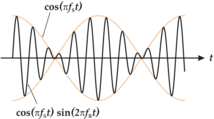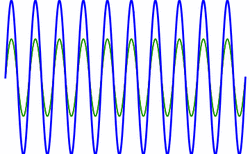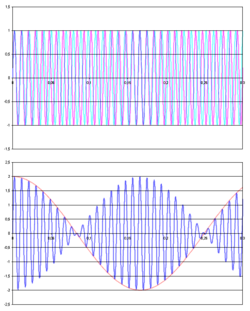Beat (acoustics)
Topic: Physics
 From HandWiki - Reading time: 6 min
From HandWiki - Reading time: 6 min
In acoustics, a beat is an interference pattern between two sounds of slightly different frequencies, perceived as a periodic variation in volume whose rate is the difference of the two frequencies.
With tuning instruments that can produce sustained tones, beats can be readily recognized. Tuning two tones to a unison will present a peculiar effect: when the two tones are close in pitch but not identical, the difference in frequency generates the beating. The volume varies like in a tremolo as the sounds alternately interfere constructively and destructively. As the two tones gradually approach unison, the beating slows down and may become so slow as to be imperceptible. As the two tones get further apart, their beat frequency starts to approach the range of human pitch perception,[1] the beating starts to sound like a note, and a combination tone is produced.
Mathematics and physics of beat tones
This phenomenon is best known in acoustics or music, though it can be found in any linear system: "According to the law of superposition, two tones sounding simultaneously are superimposed in a very simple way: one adds their amplitudes".[2] If a graph is drawn to show the function corresponding to the total sound of two strings, it can be seen that maxima and minima are no longer constant as when a pure note is played, but change over time: when the two waves are nearly 180 degrees out of phase the maxima of one wave cancel the minima of the other, whereas when they are nearly in phase their maxima sum up, raising the perceived volume.
It can be proven with the help of a sum-to-product trigonometric identity (see List of trigonometric identities) that the envelope of the maxima and minima form a wave whose frequency is half the difference between the frequencies of the two original waves. Consider two sine waves of unit amplitude:[3]
- [math]\displaystyle{ { \cos(2\pi f_1t)+\cos(2\pi f_2t) } = { 2\cos\left(2\pi\frac{f_1+f_2}{2}t\right)\cos\left(2\pi\frac{f_1-f_2}{2}t\right) } }[/math]
If the two original frequencies are quite close (for example, a difference of approximately twelve hertz),[4] the frequency of the cosine of the right side of the expression above, that is f1 − f2/2, is often too low to be perceived as an audible tone or pitch. Instead, it is perceived as a periodic variation in the amplitude of the first term in the expression above. It can be said that the lower frequency cosine term is an envelope for the higher frequency one, i.e. that its amplitude is modulated. The frequency of the modulation is f1 - f2/2, while the carrier or average frequency is f1 + f2/2. It can be noted that every second burst in the modulation pattern is inverted. Each peak is replaced by a trough and vice versa. However, because the human ear is not sensitive to the phase of a sound, only its amplitude or intensity, only the magnitude of the envelope is heard. Therefore, subjectively, the frequency of the envelope seems to have twice the frequency of the modulating cosine, which means the audible beat frequency is:[5]
- [math]\displaystyle{ f_\text{beat}=f_1-f_2\, }[/math]
This can be seen on the adjacent diagram.
Binaural beats
File:Binaural beat lossless new.wav File:Pure Alpha Waves 7 to 12,9 Hz Binaural Beats V3.wav
A binaural beat is an auditory illusion perceived when two different pure-tone sine waves, with a less-than 40 Hz or so difference between them, are presented to a listener dichotically (one through each ear).
For example, if a 530 Hz pure tone is presented to a subject's right ear, while a 520 Hz pure tone is presented to the subject's left ear, the listener will hear beating at a rate of 10 Hz, just as if the two tones were presented monaurally, but the beating will have an element of lateral motion as well.
Binaural-beat perception originates in the inferior colliculus of the midbrain and the superior olivary complex of the brainstem, where auditory signals from each ear are integrated and precipitate electrical impulses along neural pathways through the reticular formation up the midbrain to the thalamus, auditory cortex, and other cortical regions.[6]
According to a 2023 systematic review, studies have investigated some of the claimed positive effects in the areas of cognitive processing, affective states (like anxiety), mood, pain perception, meditation and relaxation, mind wandering, creativity, but the techniques were not comparable and results were inconclusive.[7]
Uses
Musicians commonly use interference beats objectively to check tuning at the unison, perfect fifth, or other simple harmonic intervals.[8] Piano and organ tuners use a method involving counting beats, aiming at a particular number for a specific interval.
The composer Alvin Lucier has written many pieces that feature interference beats as their main focus. Italian composer Giacinto Scelsi, whose style is grounded on microtonal oscillations of unisons, extensively explored the textural effects of interference beats, particularly in his late works such as the violin solos Xnoybis (1964) and L'âme ailée / L'âme ouverte (1973), which feature them prominently (Scelsi treated and notated each string of the instrument as a separate part, so that his violin solos are effectively quartets of one-strings, where different strings of the violin may be simultaneously playing the same note with microtonal shifts, so that the interference patterns are generated). Composer Phill Niblock's music is entirely based on beating caused by microtonal differences.[9] Computer engineer Toso Pankovski invented a method based on auditory interference beating to screen participants in online auditory studies for headphones and dichotic context (whether the stereo channels are mixed or completely separated).[10]
Sample
See also
- Autonomous sensory meridian response (ASMR)
- Consonance and dissonance
- Gamelan tuning
- Heterodyne
- Moiré pattern, a form of spatial interference that generates new frequencies.
- Music and sleep
- Voix céleste
References
- ↑ Levitin, Daniel J. (2006). This is Your Brain on Music: The Science of a Human Obsession. Dutton. p. 22. ISBN 978-0525949695.
- ↑ Winckel, Fritz (1967). Music, Sound and Sensation: A Modern Exposition, p. 134. Courier. ISBN:978-0486165820.
- ↑ "Interference beats and Tartini tones", Physclips, UNSW.edu.au.
- ↑ "Acoustics FAQ", UNSW.edu.au.
- ↑ Roberts, Gareth E. (2016). From Music to Mathematics: Exploring the Connections, p. 112. JHU. ISBN:978-1421419190.
- ↑ Oster, G (October 1973). "Auditory beats in the brain". Scientific American 229 (4): 94–102. doi:10.1038/scientificamerican1073-94. PMID 4727697. Bibcode: 1973SciAm.229d..94O.
- ↑ Ingendoh, R. M.; Posny, E. S.; Heine, A. (2023). "Binaural beats to entrain the brain? A systematic review of the effects of binaural beat stimulation on brain oscillatory activity, and the implications for psychological research and intervention". PLOS ONE 18 (5): e0286023. doi:10.1371/journal.pone.0286023. PMID 37205669.
- ↑ Campbell, Murray; Greated, Clive A.; and Myers, Arnold (2004). Musical Instruments: History, Technology, and Performance of Instruments of Western Music, p. 26. Oxford. ISBN:978-0198165040. "Listening for beats can be a useful method of tuning a unison, for example between two strings on a lute,..."
- ↑ "Identity through instability". 2012-12-13. https://eprints.hud.ac.uk/id/eprint/16271/3/GloverPhillIdentity.pdf.
- ↑ "Screening For Dichotic Acoustic Context And Headphones In Online Crowdsourced Hearing Studies" (in en). Canadian Acoustics 49 (2). 2021-07-07. https://jcaa.caa-aca.ca/index.php/jcaa/article/view/3403. Retrieved 2021-07-07.
Further reading
- Thaut, Michael H. (2005). Rhythm, music, and the brain : scientific foundations and clinical applications (1st in paperback ed.). New York: Routledge. ISBN 978-0415973700.
- Berger, Jonathan; Turow, Gabe, eds (2011). Music, science, and the rhythmic brain : cultural and clinical implications. Routledge. ISBN 978-0415890595.
External links
- Javascript applet, MIT
- Acoustics and Vibration Animations, D.A. Russell, Pennsylvania State University
- A Java applet showing the formation of beats due to the interference of two waves of slightly different frequencies
- Lissajous Curves: Interactive simulation of graphical representations of musical intervals, beats, interference, vibrating strings
- The Feynman Lectures on Physics Vol. I Ch. 48: Beats
da:Beat
 |
 KSF
KSF





